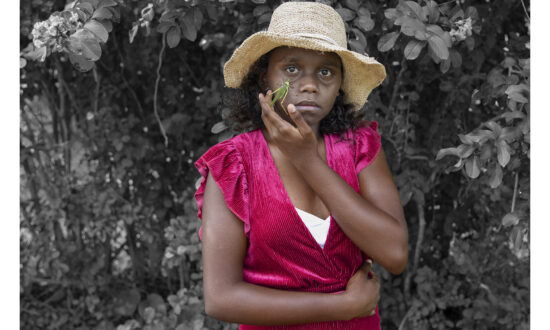After the Fall – an exploration of grief, faith and end-times
Flinders University Museum of Art
After the Fall is the latest iteration of The Guildhouse Collections Project, which enables artists to immerse themselves in some of South Australia’s significant public collections. In this instance, Elyas Alavi, Kate O’Boyle and Louise Haselton have delved into the European print collection at the Flinders University Museum of Art (FUMA), creating new works exploring grief, faith, and end-times.
Curated by Alice Clanachan, After the Fall was initially inspired by the biblical Fall, represented in the FUMA collection by the print Adam and Eve driven out of Paradise by British artist John Martin (1789-1854). In this work, Martin illustrates a scene from John Milton’s Paradise Lost, where Adam and Eve are banished by God from the Garden of Eden as a result of eating the forbidden fruit. As God had promised, they became mortal.
While Alavi, O’Boyle and Haselton explored different areas of the European print collection, their selections have come together cohesively to create an exhibition of musings on the role of art in making sense of a fallen world. New works sit alongside important historical pieces, creating a narrative of how artists have responded to wars, pandemics, ecological collapse and social upheavals from the renaissance to contemporary times.

Some of the historical prints displayed in After the Fall at FUMA. Photo: Sia Duff
Alavi, an Afghan-born Hazara refugee, often deals with notions of displacement, memory, migration and identity in his practice. For this exhibition, he has created new works that reference the fall of Kabul to the Taliban on the night of August 15, 2021, and the subsequent collapse of the Afghan Government.
The video work Tamam (a Farsi word meaning “the end” or “finished”) comprises mobile phone footage from the streets of Kabul in the days after the fall. Alavi’s interest in the prints of Francis Goya and Jacques Callot can be seen in his paintings Drowning I and II, which depict the horrors and grief of war.

Drowning II, by Elyas Alavi, in After the Fall. Photo: Sia Duff
Studying the FUMA European Print Collection meant that O’Boyle was able to extend her PhD research into Christian materiality. This journey was sparked by the work, The Virgin Protecting two members of a confraternity, by Agostino Carracci after Veronese (1582). The print portrays Mary as a larger-than-life figure sheltering under her cape two men who are looking up at her in adoration.
O’Boyle’s video work, There’s Something About Mary, is particularly fascinating as it depicts Queensland’s Marian Valley, the Catholic site of pilgrimage. The valley is dedicated to the Virgin Mary and over the years several impressive shrines and chapels have been built, specific to different ethnic Catholic communities, providing a tranquil place for reflection and meditation. O’Boyle is fascinated by the stories of hope and triumph of those who make the pilgrimage, and how these shrines and chapels engage with the surrounding environment.
Alongside the video work is O’Boyle’s sculptural piece, Mother wound, which views Mary as a protector against the pandemic. The work consists of a large cape made out of PPE COVID gowns with the various names for Mary sewed into the fabric.
For Haselton, who has been working in sculpture for two decades, the Collections Project was an opportunity to not only explore these fascinating prints but also to experiment with the art of printmaking. Haselton was interested in works in the collection that depict human catastrophe and folly, and was particularly drawn to the 1493 book Liber Chronicarum or The Nuremberg Chronicle. The Chronicle – which is structured around the seven ages of the world, from Creation to the Last Judgment – was the most lavishly illustrated book printed in Europe at the time.

Get InReview in your inbox – free each Saturday. Local arts and culture – covered.
Thanks for signing up to the InReview newsletter.
In After the Fall, Haselton presents a series of prints that are inspired by the illustrations of human oddities in the Chronicle. For example, the work Wink Wink references a figure whose mouth is so small that he has to eat and drink through a straw and winks to communicate.

Plate 2 and Plate 3 from the series Chronicle, by Louise Haselton. Photo: Sia Duff
After the Fall is a fascinating exhibition that not only presents new work by three talented contemporary artists working across a range of media, but also brings to light some of the treasures from FUMA’s art collection. The works on display allow the audience to revisit and reinterpret some of the signature pieces of the European art collection in contrast to the new works inspired by them.
The Guildhouse Collections Project: After the Fall, part of the 2022 SALA program, is at FUMA (at Flinders University, Bedford Park) until September 16. There will be an artist talk on August 25.
Support local arts journalism
Your support will help us continue the important work of InReview in publishing free professional journalism that celebrates, interrogates and amplifies arts and culture in South Australia.
Donate Here




